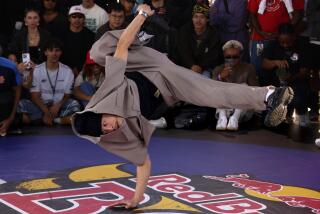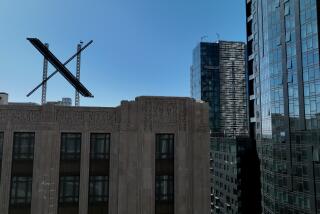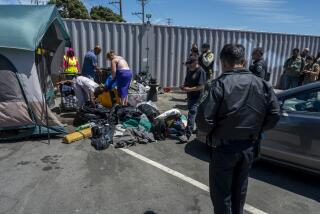Buskers Earn a Living, Acceptance in Bay City
- Share via
SAN FRANCISCO — Funny is different here. Take a couple of college freshmen, say “no” to their scholarship requests and turn them loose.
It sounds like a recipe for disaster, but Jonathon Park and Scott Meltzer hit the streets of San Francisco juggling.
Says Jonathon, as he tosses a bowling ball, a Ping-Pong ball and a borrowed purse around, “This is a difficult act to do because of the unequal weight distribution . . . because this lady’s purse is such an ugly color.”
The pair call themselves the American Dream Juggling Team, a name that has taken them from the casinos of Las Vegas to network TV and the halls of IBM.
But their real performing home is the street, where they juggle on unicycles and on each other’s shoulders, creating fountains of battle axes, torches, vacuum cleaners and battery-operated hedge clippers. For fun. And money--they pass the hat after every show.
The World’s Best
Dozens of street performers pass their hats around San Francisco every day of the year, including some of the world’s best. The one-two-three winners of the 1986 International Street Performers Competition in Milan are all from the City by the Bay.
Jugglers Andrew Potter and Wheeler Cole, who usually work the sidewalks of the Cannery, won first prize and $6,000. Cliff and Mary Spenger, who walk the slack rope at Pier 39, picked up $4,000 for second place; comic and stilt walker Ned Kelley, who also hangs out at the Cannery, came home with the $2,500 third prize.
But international prizes aren’t enough to keep the buskers going. Fun has a lot to do with it. “I could get a job as a computer programmer,” Meltzer says, “but street performing is a lot more rewarding.”
The money helps, too. “The sound of jingling coins offends my ears,” juggler Mitchell Barrett tells a crowd. “This hat only accepts paper.”
Gold in the Streets
Street performers don’t like to talk about just how full their hats get, but there are whispers of $50,000 and $60,000 a year. “At $1 each from a third of the crowd on a bad day,” goes one estimate, “and only three shows a day, you’re talking $300 a day. All cash.”
But before everybody rushes out to take juggling lessons, remember the cloud that surrounds every silver lining. “It’s hard to establish good credit,” Meltzer says.
It used to be worse. In the 1960s, mime artist Robert Shields was arrested almost daily for performing in Union Square. It earned him what is probably one of the thickest arrest records in San Francisco and helped turn Shields and Yarnell into one of the first street acts to cross over into commercial success.
Shields also gathered a loyal local following that helped turn street buskers into a San Francisco institution that was at least tolerated--if not actively supported--by the local Establishment. Then came specialty shopping centers such as Ghirardelli Square and the Cannery. Always desperate for new gimmicks that would attract crowds, they turned their sidewalks and squares over to street performers.
Stages and Auditions
Some built stages and held regular auditions to screen prospective talent. Pier 39 went one step further and created the Street Performers Festival, won this year by the American Dream Juggling Team.
These are some of the more popular street performers’ hangouts, but acts are likely to pop up wherever there are people and room to draw a crowd:
Aquatic Park, the bay end of the Hyde Street cable car line; the Cannery, just west of Fisherman’s Wharf; Fisherman’s Wharf, one of the city’s oldest attractions; Ghirardelli Square, next to Aquatic Park; Hallidie Plaza, near the cable car terminus on Market Street; Pier 39, just east of Fisherman’s Wharf; Union Square, across from the Westin St. Francis Hotel.
Whether they’re performing on stage or sidewalk, street performers are always worth a look. Success has already struck the Flying Karamazov Brothers, A. Whitney Brown, Harry Anderson and others.
So the next time somebody starts performing on the street, pay attention. By this time next year you might be able to say, “I saw them when they were passing the hat in San Francisco.”
More to Read
Sign up for Essential California
The most important California stories and recommendations in your inbox every morning.
You may occasionally receive promotional content from the Los Angeles Times.










